Editor’s Note: On June 29, the Rev. Christian Hawley began writing a weekly series on trails for the San Marcos Record. The first of these focused on trails in Purgatory Creek Natural Area and their relationship with Dante’s Divine Comedy. In the event you missed them, they’re reprinted below.
Welcome to Trail Notes, a weekly column highlighting trails, trail life and even trail gear. By way of introduction, my name is Christian Hawley. Last year I wrote an article called the San Marcos Traverse about running all the trails in our town, and this year Susan Hanson has written a couple of articles about my parish, St Mark’s, and our partnership with SMGA to create a public nature trail on 20 acres of our church property. I have also written for Trail Runner Magazine, the Outdoor Journal and Task and Purpose. Suffice it to say, I love trails.
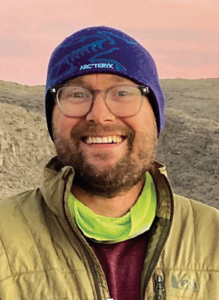 Raised in East Tenn., I grew up on the Appalachian Trail, and I have logged every mile from Springer Mountain, Ga. to Mt Rogers, Va., not to mention a few additional treks up the Shenandoah Valley of Virginia and the Presidential Traverse of New Hampshire. My time in the military and my wanderings afterward took me up the Barr Trail of Pike’s Peak, down a path in Shivapuri Nagarjun National Park to the Kathmandu Valley, Nepal, and through the high deserts of Idaho and Bolivia. For family reunions, we hiked Italy’s Cinque Terra. For my bachelor party, we ran through Bryce Canyon and Zion National Parks, and for my 40th birthday, we backpacked the Hoh River Rainforest trail to the glaciers of Mt. Olympus. Along the way, I met a Texan.
Raised in East Tenn., I grew up on the Appalachian Trail, and I have logged every mile from Springer Mountain, Ga. to Mt Rogers, Va., not to mention a few additional treks up the Shenandoah Valley of Virginia and the Presidential Traverse of New Hampshire. My time in the military and my wanderings afterward took me up the Barr Trail of Pike’s Peak, down a path in Shivapuri Nagarjun National Park to the Kathmandu Valley, Nepal, and through the high deserts of Idaho and Bolivia. For family reunions, we hiked Italy’s Cinque Terra. For my bachelor party, we ran through Bryce Canyon and Zion National Parks, and for my 40th birthday, we backpacked the Hoh River Rainforest trail to the glaciers of Mt. Olympus. Along the way, I met a Texan.
I knew my now spouse was the one when we set up a tent in the dark after hiking 13 miles around Big Bend’s South Rim Trail, a trip that changed how I thought about both her and hiking in Texas. She wisely enrolled us in the Master Naturalist program a few years later and then became my adventure partner in excursions through state parks: Caprock Canyon, Palo Duro Canyon, Big Bend Ranch, Davis Mountains, Lost Maples, Hill Country Natural Area, LBJ Ranch, Bastrop, Buescher, McKinney Falls, McKinney Roughs, Palmetto and Garner, just to name a few, but our favorite local getaway has always been Pedernales Falls State Park. Then we had kids, and our relationship with trails changed again.
We went from 50k trail races and multi-day backpacking treks to running strollers and child hiking backpacks. After an awe-inspiring and disastrous trip to Yosemite with a 22-month-old, we learned to slow down and appreciate the micro miracle of tossing rocks into the Merced River instead of trying to conquer macro wonders like Half Dome. We added a second adventure gnome the next year, and our life and our trails became more about what we could “I Spy” on our local paths.
Luckily, our little 864sf house in South Austin nestled itself right next to the Stephenson Nature Preserve, where we went for daily woods walks, created tree art, and ran with the local running community Trail Roots. In 2022, we moved to San Marcos, and while we were excited to live by the river, we were lamenting what we thought would be a downgrade in trail life. Three years later, I’m happy to report we were delightfully wrong.
San Marcos is a great trail town. Texas is a wonderful trail state. The USA is a fantastic trail country, and we live on a fabulous trail planet. So every Sunday in this little column, I hope to give you a little glimpse of why.
Hiking the Divine Comedy, Part I: Meet Dante and Virgil
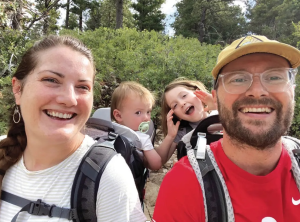
I first discovered the Purgatory Creek Trail system in 2015, a few years removed from seminary, where I had a healthy church-nerd crush on Dante Alighieri. I stood in utter shock and delight that warm July morning as I gazed at the trail names pulled from Dante’s classic, the Divine Comedy, which recounts his journey through the depths of the Inferno, up the mountain of Purgatory, before finally bathing in the Beatific light of Paradiso. Ever since that glorious day in 2015, I have longed to hike this trail system, following in the footsteps of Dante.
That quest necessitated a grueling consultation session at Rough House Brewing with Daniel Strandlund, former vicar of St. Elizabeth in Buda, and current Dante Scholar at Oxford University, England. We pored over numerous libations and maps to find a route that matched the Italian literature with the Texas trails. Now, ten years later, I walk in the footsteps of that Florentine genius. So come along on a literary adventure, where we’ll journey the route from hell to heaven and back again…mostly. The Divine Comedy opens with the words, “Midway upon the journey of our life, I found myself within a forest dark, for the straightforward pathway had been lost.” Our hike doesn’t begin with such melancholy confusion; simply park at the Lower Purgatory Trailhead at 2116 Hunter Road.
Our odyssey commences on the Dante Trail, named for the thirteenth-century author from Florence, Italy. Dante is not only the author, but the protagonist of the Divine Comedy, and appropriately, the Dante Trail connects all the other trails on our hike today. As we progress down the Dante Trail, the wide, crushed granite path gives way to a narrow, dirt track pulling us into a forest dark where the straightforward path is easily lost. Here we come to an intersection with the Acheron trail, and we take our first turn.
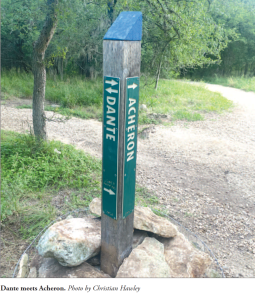
(photo by Christian Hawley)
Acheron serves as the river separating this world from Hades in Greek mythology, and in the Divine Comedy, it serves a similar purpose, dividing the approach to Hell from Hell proper. In our trail system, Acheron runs along a main drainage ditch of the park, and if you happen to hike it after a good rain, it serves as an effective riparian border. This short trail swings back around to the Dante path right at a bridge ready to ferry us to the other side of the Acheron.
Strictly speaking, Charon, the ferryman of Greek mythology, carried people across the rivers of Hell, but the SMGA chose to name this particular bridge, Matilda, in honor of the woman who ferried Dante across the river Lethe, which separates Purgatory from Paradise. We’ll forgive a few little literary liberties in favor of a more optimistic hiking experience. Curiously enough, the River Lethe washed away troubling memories, and once on the other side of this bridge, I always feel a little lighter and more present with nature.
The Dante trail now winds its way up an incline (feeling very purgatory-esque), before flattening out and making its way back to Wonderworld Drive where it intersects the Virgil Trail under the thundering noise of the elevated roadway gods.
The Virgil Trail references the great Roman poet and author of the Aeneid. In the Divine Comedy, Virgil serves as Dante’s guide through the Inferno, and if there is a corollary in our day, it would be Todd Derkacz, SMGA’s lead trailblazer, and the one responsible for the Divine Comedy trail names.
When I asked our modern-day Virgil how the names came about, he said, “The creek was called Purgatory Creek. The Natural Area was given the same name. Back in the early aughts, I read the Divine Comedy and realized it was a Rolodex of names from Western history. We needed names, and I liked the idea of having a theme that challenged folks just a bit. Since no one else seemed to care or even know what we (Sheila Torres-Blank and a few others on crew) were up to, it stuck.”
Up for Todd and Sheila’s challenge, we plunge on. Next week we’ll traverse an infernal path from Limbo to the River Styx.
Hiking the Divine Comedy Part II: From Limbo to the River Styx
Last week, we began a journey through Dante’s Divine Comedy and our Purgatory Creek Trail system. We left off under Wonderworld Drive, where the Dante Trail intersects with the Virgil Trail. As we move toward Prospect Park, our time on the wide, graded Virgil path is fleeting, and we soon jump on to the more primitive Limbo Loop Trail.
If any of you have an Italian grandmother like me, you’ll know Limbo as the gray place on the edge of Hell where all unbaptized babies go after death. The Roman Church did away with Limbo in 2007, but don’t tell my Nonni, Beatrice Barzetti, or Dante Alighieri that. For Dante, this was the realm of the virtuous pagan, hence his encounter with Virgil. For us, it’s a rocky loop, great for birding and hill country views. Especially nice is the Metz bench where we might stop and read some poems by the other occupants of Dante’s Limbo: Homer, Horace or Ovid, the inspiration for our next trail.
To get to the Ovid trails at Purgatory Creek, we must complete our Limbo circuit and backtrack on the Virgil Trail to return to the Dante Path, which now moves out from under Wonderworld Drive and back toward the dam. Eventually, we come to a dizzying intersection of the Dante Trail, the Ripheus Trail (more on him later), and the Ovid West Trail. In keeping with the path of literature, we jump on the Ovid West Trail here, where, true to its name, an abundance of wildflowers greets us for most of the year.
Ovid’s most famous works are Metamorphoses (Transformations) and Amores (Loves), and these trails, Ovid West and Ovid East, reflect these virtues as they usher us from field to forest, and season to season through a wildflower progression that includes Bluebonnets, Firewheels and Turk’s Caps. Yet our time on this trail is short, as we must push deeper into the Inferno, so we jump back on the Dante trail at our next intersection and make for the depths of Hell. Malacoda, the leader of the twelve demons guarding the eighth circle of hell, awaits us.
Contrary to the literature, the walk from Ovid to Malacoda is delightful, full of ancient oaks with the raiment of Spanish Moss and the songs of Canyon Wrens echoing along the bluffs. After passing the Beatrice Trail (we’ll come back to her, too), we finally reach the intersection with the Malacoda Loop Trail.
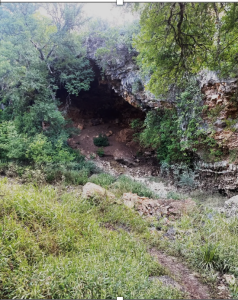
In Dante’s Inferno, Malacoda guards and torments the grafters (those guilty of bribery, political corruption, etc.). This altogether rotten character couldn’t be a worse representation of this beautiful loop in the heart of the Purgatory Trail system. Going clockwise, this trail circumnavigates a picturesque meadow between two bluffs, the latter in the rotation, complete with its own massive cavern. If you can get your family to this spot, kids love exploring Geryon Grotto (Geryon being the demon of fraud). However fun it might be to frolic with demons and kids, we must move on to the River Styx if we’re ever going to make it to heaven.
The Dante Trail climbs the bluffs above Malacoda (take the detour to the lookout), before rolling over hill and dale, outcropping and karst on its way to the Upper Purgatory Trailhead. Quite suddenly, we break from the tree cover onto the ADA- compliant Styx Trail, where, without fail, I start singing the 1977 classic “Come Sail Away,” by the band of the same name. Like Acheron, the Styx Trail derives its name from a waterway in Hades. For Dante, the River Styx marks the swamps of anger and wrath. If we take a right onto this trail, it will deliver us to a low water crossing, which after a good rain also produces a respectable swamp. However, we turn left and finally turn our faces toward Paradise. The Styx trail makes a loop, and while either direction suits our needs, the branch to the left offers arboreal delight in the form of two giant live oaks. The second tree can be accessed by a social trail leading through a tunnel of branches and moss. The hollowed giant at the center provides one of the best natural playgrounds in San Marcos. My kids can’t ever get enough, and it’s an easy walk with a stroller from the Upper Purgatory Trailhead. But I digress. At the apex of Styx Loop, we encounter the Paraiso Trail (if we were being true to the Italian literature, this would be the Paradiso Trail, but given we’re in Texas, and this is our Purgatory Creek, the Spanish Paraiso seems appropriate). Join us next week as we finally reach Paradise and conclude our literary odyssey.
Hiking the Divine Comedy Part III: Paradise and All That Comes After
Welcome to the final chapter of our journey through Dante’s Divine Comedy on our Purgatory Creek Trail system. Having journeyed through Hell the last two weeks, we find ourselves on the brink of heaven standing at the intersection of the Paraiso trails.
Up until this year, the Paraiso Trail consisted of a single track moving West from the apex of the Styx Trail, but thanks to the hard work of the SMGA, a new one mile stretch branches to the North before rejoining the Dante Trail just before the Upper Purgatory parking lot. We’ll take the established western route past the Minotaur Canyon Look Out (the Minotaur being the half-man, half-bull creature of Cretan fame who guards the violent ring of hell) before descending back down into Purgatory Creek.
The Paraiso Trail doesn’t live up to its name in terms of terrain, as it consists mostly of jagged limestone reaching up for our feet with every step. Yet it does embody paradise according to Jean-Paul Sartre, the French existentialist who said, “Hell is other people.” The Paraiso Trail makes for miserable mountain biking and tricky hiking, so it is the least populated trail in the park. Given its meandering through remoter sections, it’s also one of the quietest, so if we’re looking for some solitude, Paraiso is indeed a little slice of heaven. Coming down from this mountain- top experience, we once again connect with the Dante Trail, backtracking our way to the Beatrice intersection.
Beatrice is my favorite character and my favorite trail in Purgatory Creek, and not just because my favorite grandmother is named for her. In Dante’s Divine Comedy, Beatrice serves as both Dante’s patron for the entire journey and his guide through Paradise. The trail in our park lives up to her adjective “beatific,” meaning blissfully happy. This is the only trail we can find shade on year-round, making it a go-to summer hike. Beatrice also provides relief from the technical limestone as we all but glide down her smooth, rich dirt trails. For trail runners and mountain bikers alike, the Beatrice Trail offers that much-sought-after flow we so often crave in a quality outing.
Eventually, that river of dopamine dumps us out at the top of the dam, where we turn our faces back to the exit, over the Acheron and to our waiting vehicles.
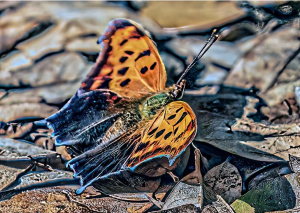
The Ripheus Trail takes off from the top of the dam and goes down to the Acheron. Curiously enough, Ripheus, the Trojan warrior from the Aeneid, is found in the sixth circle of heaven personifying justice. Virgil writes of this hero, “Uniquely the most just of all the Trojans, the most faithful preserver of equity.” Given the Ripheus Trail runs along the landscape created as part of flood control for the city, I guess there is a sense of justice-for-all in his occupying this spot on our journey. We walk with Ripheus down from the heights of heaven to a low water crossing and once again to the Acheron and Dante Trails, leading us to the parking lot and the end of our odyssey.
All said and done, we’ve covered 9.5 miles and 1,200 feet of elevation change, so this hike is not to be taken lightly as a single outing, and it is perhaps better suited to section hiking from the three major trailheads. However, if you’re feeling up to it, we might try a group hike on March 25, 2026, as it is Dante Day and the date on which the literature purports to have begun the Divine Comedy. On that day, Dante walks through gates emblazoned with the words, “Abandon hope all ye who enter here,” but given the divine joy that is our hiking trails, we might erect a gate that day declaring, “Discover hope all ye who enter here.”
Author’s note: For those of you detail lovers, you’ll notice I didn’t mention the Sinon, Minos or Nimrod trails, and that’s because they were just so far removed from their place in the literature that it was hard to connect them in any coherent fashion. That being said, I’d be remiss if I didn’t let you know that Sinon is also a Trojan soldier found in the eighth circle of hell, so his trail would have been more accurately sited near Malacoda and not Limbo. Similarly, Minos is the monstrous judge who assigns souls to their appropriate level of hell, so he would be right at home near the Limbo trail; however, he is out of place near the River Styx and Upper Purgatory. Finally, Nimrod, of Biblical infamy regarding the Tower of Babel, resides in Dante’s eighth circle of hell and so his trail’s location between Beatrice and Ripheus just doesn’t work. Trajan, the just Roman Emperor, and resident of the sixth heaven with Ripheus might be a good option if we were ever to rename the trails.

Writtten by: Christian Hawley
SMGA Member
